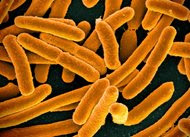Home > Press > Speedy bacteria detector could help prevent foodborne illnesses
 |
| Catching E. coli contamination in foods requires a fast sensor. Credit: National Institute of Allergy and Infectious Diseases, National Institutes of Health |
Abstract:
It seems like almost every week another food product is being recalled because of contamination. One of the more common culprits is a pathogenic strain of E. coli. To help prevent illnesses caused by this bacteria in food or water, researchers have developed a new nanosensor to rapidly detect its presence. The study appears in the journal ACS Infectious Diseases.
Speedy bacteria detector could help prevent foodborne illnesses
Washington, DC | Posted on September 21st, 2016Millions of illnesses and more than 1,000 deaths every year in the U.S. are attributable to foodborne illness caused by known pathogens, according to the Centers for Disease Control and Prevention. Conventional methods to screen food to find sickness-causing microbes can take as long as 24 hours, which is often too slow to efficiently catch tainted products before they hit store shelves. Faster methods exist, but have limitations. Magnetic resonance, for example, can detect extremely low levels of bacteria, but loses its effectiveness at higher bacteria concentrations. Fluorescence is the opposite. Tuhina Banerjee, Santimukul Santra and colleagues wanted to see if they could combine the two techniques to make a better detector.
The researchers developed a hybrid nanosensor incorporating magnetic resonance and fluorescence. Lab testing of milk showed the detector could sense varying concentrations of a pathogenic strain of E. coli known as O157:H7 in less than an hour. They also used their sensor to analyze E. coli levels in untreated lake water, which serves as a source of household water in some developing areas. Additionally, the device could be customized to detect a wide range of pathogens beyond E. coli, the researchers say.
The authors acknowledge funding from the Kansas Soybean Commission and Pittsburgh State University.
####
For more information, please click here
Contacts:
Tuhina Banerjee, Ph.D.
Department of Chemistry
Kansas Polymer Research Center
Pittsburg State University
Pittsburg, KS 66762
Phone: 620-235-4749
or
or
Santimukul Santra, Ph.D.
Department of Chemistry
Kansas Polymer Research Center
Pittsburg State University
Pittsburg, KS 66762
Phone: 620-235-4861
or
Michael Bernstein
202-872-6042
Katie Cottingham, Ph.D.
301-775-8455
Copyright © American Chemical Society
If you have a comment, please Contact us.Issuers of news releases, not 7th Wave, Inc. or Nanotechnology Now, are solely responsible for the accuracy of the content.
| Related Links |
| Related News Press |
News and information
![]() Researchers develop molecular qubits that communicate at telecom frequencies October 3rd, 2025
Researchers develop molecular qubits that communicate at telecom frequencies October 3rd, 2025
![]() Next-generation quantum communication October 3rd, 2025
Next-generation quantum communication October 3rd, 2025
![]() "Nanoreactor" cage uses visible light for catalytic and ultra-selective cross-cycloadditions October 3rd, 2025
"Nanoreactor" cage uses visible light for catalytic and ultra-selective cross-cycloadditions October 3rd, 2025
Sensors
![]() Sensors innovations for smart lithium-based batteries: advancements, opportunities, and potential challenges August 8th, 2025
Sensors innovations for smart lithium-based batteries: advancements, opportunities, and potential challenges August 8th, 2025
![]() Quantum engineers ‘squeeze’ laser frequency combs to make more sensitive gas sensors January 17th, 2025
Quantum engineers ‘squeeze’ laser frequency combs to make more sensitive gas sensors January 17th, 2025
Discoveries
![]() Researchers develop molecular qubits that communicate at telecom frequencies October 3rd, 2025
Researchers develop molecular qubits that communicate at telecom frequencies October 3rd, 2025
![]() Next-generation quantum communication October 3rd, 2025
Next-generation quantum communication October 3rd, 2025
![]() "Nanoreactor" cage uses visible light for catalytic and ultra-selective cross-cycloadditions October 3rd, 2025
"Nanoreactor" cage uses visible light for catalytic and ultra-selective cross-cycloadditions October 3rd, 2025
Announcements
![]() Rice membrane extracts lithium from brines with greater speed, less waste October 3rd, 2025
Rice membrane extracts lithium from brines with greater speed, less waste October 3rd, 2025
![]() Researchers develop molecular qubits that communicate at telecom frequencies October 3rd, 2025
Researchers develop molecular qubits that communicate at telecom frequencies October 3rd, 2025
![]() Next-generation quantum communication October 3rd, 2025
Next-generation quantum communication October 3rd, 2025
![]() "Nanoreactor" cage uses visible light for catalytic and ultra-selective cross-cycloadditions October 3rd, 2025
"Nanoreactor" cage uses visible light for catalytic and ultra-selective cross-cycloadditions October 3rd, 2025
Interviews/Book Reviews/Essays/Reports/Podcasts/Journals/White papers/Posters
![]() Spinel-type sulfide semiconductors to operate the next-generation LEDs and solar cells For solar-cell absorbers and green-LED source October 3rd, 2025
Spinel-type sulfide semiconductors to operate the next-generation LEDs and solar cells For solar-cell absorbers and green-LED source October 3rd, 2025
![]() Rice membrane extracts lithium from brines with greater speed, less waste October 3rd, 2025
Rice membrane extracts lithium from brines with greater speed, less waste October 3rd, 2025
Food/Agriculture/Supplements
![]() New imaging approach transforms study of bacterial biofilms August 8th, 2025
New imaging approach transforms study of bacterial biofilms August 8th, 2025
![]() SMART researchers pioneer first-of-its-kind nanosensor for real-time iron detection in plants February 28th, 2025
SMART researchers pioneer first-of-its-kind nanosensor for real-time iron detection in plants February 28th, 2025
![]() Silver nanoparticles: guaranteeing antimicrobial safe-tea November 17th, 2023
Silver nanoparticles: guaranteeing antimicrobial safe-tea November 17th, 2023
|
|
||
|
|
||
| The latest news from around the world, FREE | ||
|
|
||
|
|
||
| Premium Products | ||
|
|
||
|
Only the news you want to read!
Learn More |
||
|
|
||
|
Full-service, expert consulting
Learn More |
||
|
|
||








